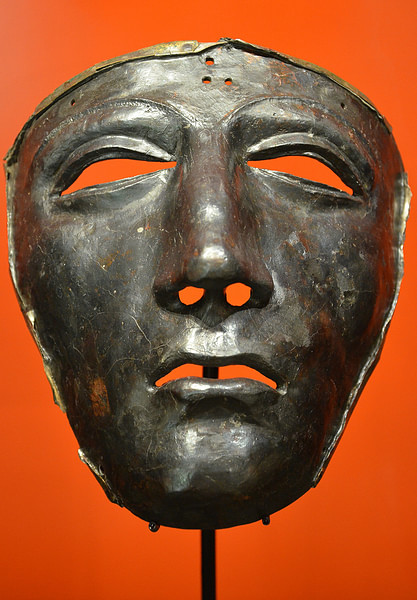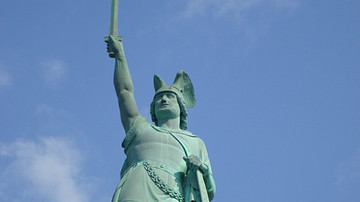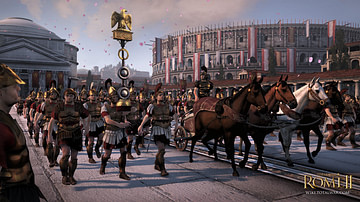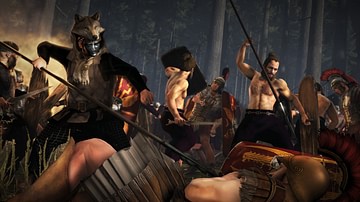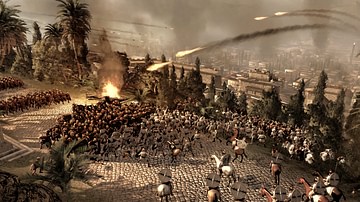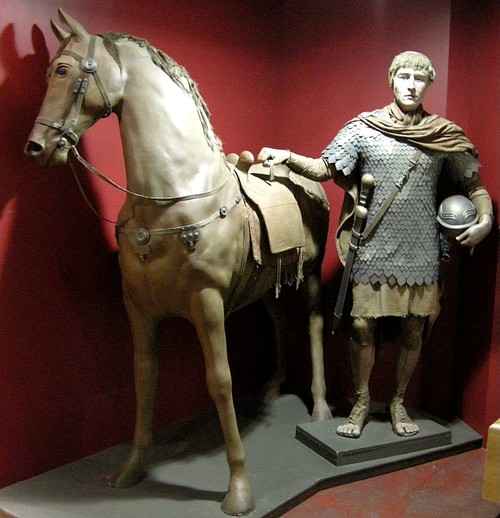
Cavalry, although never replacing infantry as the mainstay of the Roman army, could provide useful cover on the flanks of armies, could be used as a shock tactic to cause disruption to enemy infantry formations, and could pursue an enemy during the confusion of retreat. Consequently, many an ancient battle was won or lost depending on the performance of mounted soldiers. Increasingly employed over the centuries, riders also diversified so that cavalry types ranged from lightly-armoured mounted archers to heavy cavalry with lances where both rider and horse wore metal armour to leave no part of the body exposed. Cavalry also became especially useful in the later Roman period when it became necessary to patrol increasingly contentious border states.
Equites
The first Roman cavalry were the semi-legendary celeres or trossuli. These were a 300-man body of riders which the first kings of Rome incorporated into the legion, later increasing their number to 600. They carried lances and their horses were decorated with silver disks (phalerae). Servius Tullius, the 6th king of Rome (578-535 BCE), once again increased the number of the cavalry corps (equites), this time to 1,800. Members had to serve in ten campaigns but had voting rights in the assembly, their horse and equipment was provided by the state, and they enjoyed a high status, hence the predominance of aristocrats in their ranks. Around 400 BCE the cavalry was further expanded with riders who paid for their own horse (equites equo privato) but who did not enjoy the same privileges or status as the older equites. Nevertheless, cavalry members received higher pay than infantry. Although the equites corps continued to supply officer material for the army, by the 2nd century BCE Italian cavalry was used less and less in Roman warfare and their role was replaced by foreign auxilia.
Auxilia
From the 1st century BCE cavalry members most often came from provinces outside Italy and allied states could also provide cavalry forces when required. Classified as auxilia, these troops formed cavalry wings or alae. These came in two group sizes: quingenaria having 512 men and milliaria having 768. A cavalry troop (turma) consisted of 30 men with two officers and commanded by a decurio. There were also mixed cohorts of infantry and cavalry (cohortes equitatae). The cavalry was really only a minor detachment though, totalling 128 of the 512, or 256 of the 768-man unit. We know, for example, of such an equitatae in Syria in the 3rd century CE which actually had 923 members, 223 of which were cavalry and 34 were camel riders. Command of these units remained in the hands of Roman officers with the title of praefecti but, over the centuries, the difference between auxilia and regular legionaries became less distinct.
Cavalry did increase in prominence in the Roman army over time, although never replaced infantry in importance, and especially in the late Empire when it became necessary to patrol increasingly restless frontier peoples with greater troop mobility. From the reign of Diocletian, cavalry perhaps made up one third of the Roman army and new units of 500-strong cavalry known as vexillations patrolled the northern frontiers. These units were named after the square vexillum standard they carried.
The Horse
The Romans inherited knowledge of horses from the Greeks and amassed a corpus of expertise which covered the best types of horses to employ, the most effective tackle and training methods to use, and the most effective veterinary practices. Stallions from Parthia, Persia, Media, Armenia, Cappadocia, Spain, and Libya were the most prized. Preferring larger animals, horses were also selected for their temperament, stamina, and resistance to extreme environments and food deprivation. Training ensured horses became used to group charges, flashing weapons, battle noises, and strange animals such as elephants which the enemy might field.
Horses were fed barley and each cavalryman was allotted six bushels each month. According to Polybius a horse received 3.5 pounds per day. Despite every care taken, horses ran the risk of disease and injury, by far the most common being lameness - largely because horses were unshod. In battle, less serious wounds to the animal could be treated but the biggest threat came from infected wounds.
For the rider to better control the horse, various tack such as bitting and saddlery were used. The bits placed in the horse's mouth and connected to the reins were often harsh so as to provide an immediate response from the animal, and there is ample evidence that riders wore spurs. Horses could also be muzzled to prevent them biting each other when in close formation. The Roman saddle was made of leather-covered wood and had two front and two rear horns to keep the rider in position, especially important as there were no stirrups. They were also, no doubt, useful for hanging the bits and pieces of a cavalryman's equipment.
Horses and riders trained in purpose-built pens and then progressed to long marches and the practice of maneuvers such as charges and counter-charges on a variety of terrains. There were also tournaments (hippika gymnasia) to provide incentive to perfect riding skills.
Weapons & Armour
Although weaponry could be up to the individual alae, depending on where they came from, standard Roman cavalry wore mail or scale armour and carried a flat or curved, oval, round, or even elongated hexagonal shield (thyreos) of wood covered in hide, edged in metal with a central boss, and decorated with identification designs. Riders wore a helmet which was similar to the infantry's but typically with extra protection for the ears and usually more highly decorated. Weapons included the broad sword (spatha, up to 90 cm long) or long sword (machaira) and short throwing spears (akontes), of which there were three hung in a quiver on the horse's flank and which could also be used for thrusting. Riders could also carry extra weapons such as spiked axes and maces.
The contarri cavalry used a long lance (lanceae or kontos) but were never employed in large numbers, and there were also specialized lighter cavalry, for example, mounted archers. Heavy cavalry (cataphractarii), where the rider and horse wore metal armour, was also used, especially in the eastern provinces. Prevalent from the 2nd to 5th century CE, the articulated armour was composed of a double layer of linen with scales of copper alloy or iron sewn on. The horse would have been so protected on its flanks with also the neck, head, chest, tail, and legs protected by metal or leather covers. The rider wore articulated armour to protect the back and chest and often wore a metal mask and protective guards for the thighs and shins. His weapon was the contus, a heavy lance measuring 3.5 metres in length which required two hands to wield effectively. It cannot have been comfortable to carry around all this heavy metal, and armoured cavalry gained the nickname of clibanarii, meaning 'oven men', in reference to the heat suffered by the wearer.
Strategies & Development
The Romans learnt from Greek expertise in horsemanship but, even so, they were often outclassed by the opposition in the early Republic period, notably by the Carthaginians. Hannibal's Numidian cavalry force helped inflict a resounding defeat on the Romans at the Battle of Trebia in 218 BCE and again at Trasimene in 219 BCE. Hasdrubal, commanding 10,000 Celtic and Numidian cavalry alongside Hannibal's 40,000 infantry, took on Rome's 6,000 cavalry and 80,000 infantry at the Battle of Cannae in 216 BCE and enjoyed similar success. According to Polybius, at Cannae the Roman cavalry force was reduced to just 370 survivors. With 50,000 Roman dead the battle was one of Rome's heaviest ever defeats. Eventually, though, the Romans improved enough to win against Hannibal at the Battle of Zama in 202 BCE, albeit with Numidian cavalry now on the Roman side.
Notwithstanding the disastrous defeat of Marcus Licinius Crassus at the hands of the skilled Parthian cavalry at Carrhae in 53 BCE, cavalry continued to play an important military role as part of Julius Caesar's army in the Gallic wars. Caesar recruited riders from wherever he could, even Gallic tribes. He also improved weapons by adopting lances with points at each end and had cavalry employ larger shields.
In battle, cavalry were typically deployed on the flanks, organised in their turmae in three ranks, and used to protect and screen the infantry in the initial stages of battle and then to later harry the flanks and rear of the enemy infantry lines. Riders could also be arranged in an echelon formation with each horse receiving at least some protection from the shield of the rider in front. In the closing stages of battle, cavalry could also pursue and mop up a retreating army. Battle maneuvers were orchestrated by standard bearers and trumpeters.
As the empire grew and more and more skilled horsemen were incorporated into the Roman military machine, the standard of Roman cavalry improved and became one of the reasons why Rome's enemies avoided full-scale set-piece battles. However, from the 5th century CE, Roman military dominance began to crack and the empire suffered several damaging attacks, notably by the light-armed cavalry archers of the Huns, which allowed their leader, Attila, to sack many a Roman city. The use of cavalry survived the fall of the Roman Empire, though, as it became an important element of Byzantine and Medieval armies.
